Taxation Law Assignment: Australian Taxation System Analysis
VerifiedAdded on 2023/02/01
|12
|2825
|55
Homework Assignment
AI Summary
This taxation law assignment provides a detailed analysis of the Australian taxation system. It addresses key concepts such as the legislative power of the commonwealth, the role of the ATO, and the impact of double taxation agreements. The assignment delves into specific scenarios involving capital gains tax (CGT), business expenditure, and allowable deductions, providing practical examples and interpretations of relevant tax laws. It examines pre-CGT and post-CGT assets, the implications of property subdivisions, and the tax treatment of various income-generating activities. Furthermore, the assignment explores the application of CGT to different assets, including main residences, shares, and vacant land. The assignment also includes analysis of ATO measures regarding inequitable inquiries and multinational tax avoidance, along with the role of tax advisors in ensuring compliance. The assignment provides comprehensive answers to questions related to these topics, supported by relevant case law and legislative references.
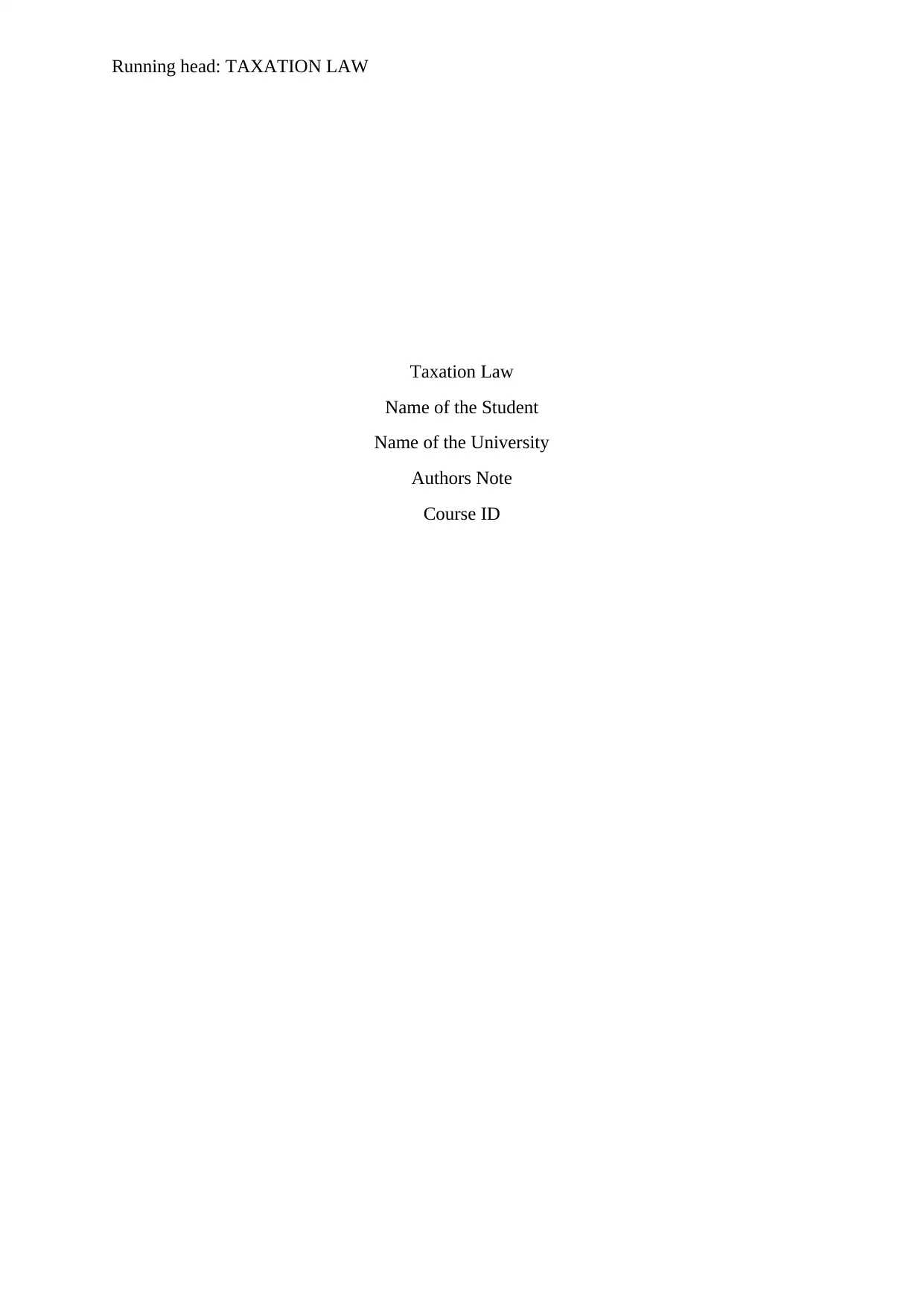
Running head: TAXATION LAW
Taxation Law
Name of the Student
Name of the University
Authors Note
Course ID
Taxation Law
Name of the Student
Name of the University
Authors Note
Course ID
Paraphrase This Document
Need a fresh take? Get an instant paraphrase of this document with our AI Paraphraser
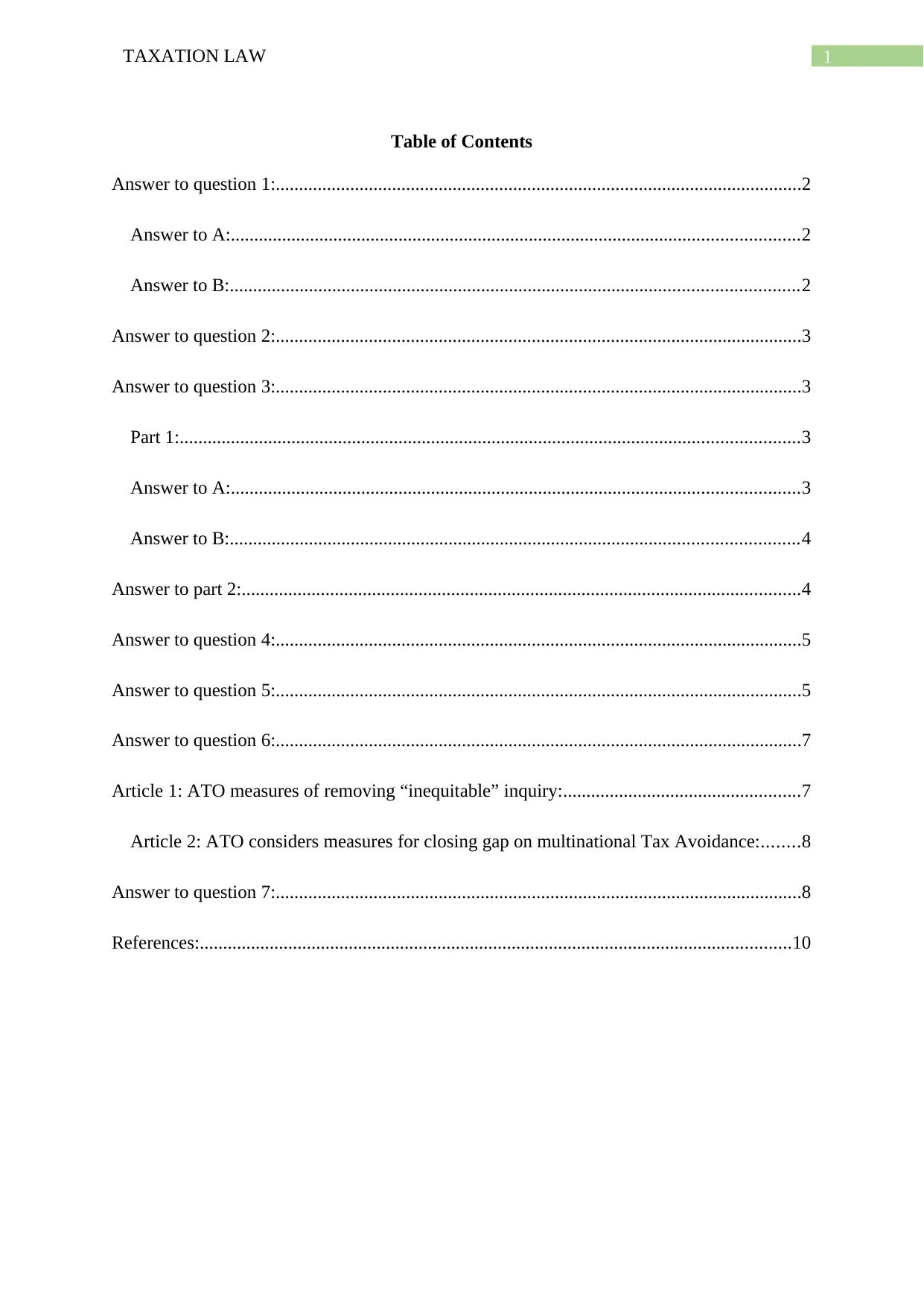
1TAXATION LAW
Table of Contents
Answer to question 1:.................................................................................................................2
Answer to A:..........................................................................................................................2
Answer to B:..........................................................................................................................2
Answer to question 2:.................................................................................................................3
Answer to question 3:.................................................................................................................3
Part 1:.....................................................................................................................................3
Answer to A:..........................................................................................................................3
Answer to B:..........................................................................................................................4
Answer to part 2:........................................................................................................................4
Answer to question 4:.................................................................................................................5
Answer to question 5:.................................................................................................................5
Answer to question 6:.................................................................................................................7
Article 1: ATO measures of removing “inequitable” inquiry:...................................................7
Article 2: ATO considers measures for closing gap on multinational Tax Avoidance:........8
Answer to question 7:.................................................................................................................8
References:...............................................................................................................................10
Table of Contents
Answer to question 1:.................................................................................................................2
Answer to A:..........................................................................................................................2
Answer to B:..........................................................................................................................2
Answer to question 2:.................................................................................................................3
Answer to question 3:.................................................................................................................3
Part 1:.....................................................................................................................................3
Answer to A:..........................................................................................................................3
Answer to B:..........................................................................................................................4
Answer to part 2:........................................................................................................................4
Answer to question 4:.................................................................................................................5
Answer to question 5:.................................................................................................................5
Answer to question 6:.................................................................................................................7
Article 1: ATO measures of removing “inequitable” inquiry:...................................................7
Article 2: ATO considers measures for closing gap on multinational Tax Avoidance:........8
Answer to question 7:.................................................................................................................8
References:...............................................................................................................................10
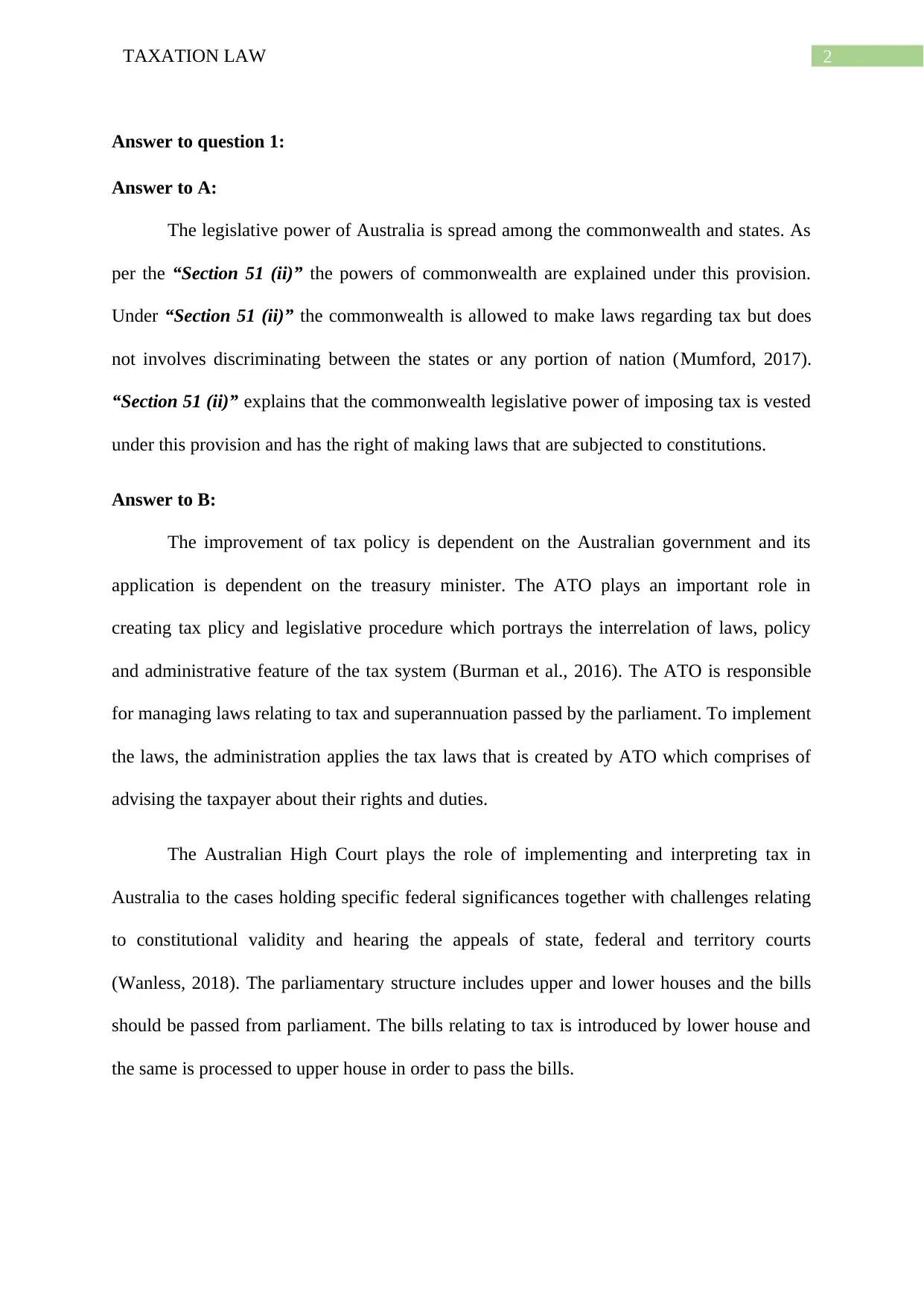
2TAXATION LAW
Answer to question 1:
Answer to A:
The legislative power of Australia is spread among the commonwealth and states. As
per the “Section 51 (ii)” the powers of commonwealth are explained under this provision.
Under “Section 51 (ii)” the commonwealth is allowed to make laws regarding tax but does
not involves discriminating between the states or any portion of nation (Mumford, 2017).
“Section 51 (ii)” explains that the commonwealth legislative power of imposing tax is vested
under this provision and has the right of making laws that are subjected to constitutions.
Answer to B:
The improvement of tax policy is dependent on the Australian government and its
application is dependent on the treasury minister. The ATO plays an important role in
creating tax plicy and legislative procedure which portrays the interrelation of laws, policy
and administrative feature of the tax system (Burman et al., 2016). The ATO is responsible
for managing laws relating to tax and superannuation passed by the parliament. To implement
the laws, the administration applies the tax laws that is created by ATO which comprises of
advising the taxpayer about their rights and duties.
The Australian High Court plays the role of implementing and interpreting tax in
Australia to the cases holding specific federal significances together with challenges relating
to constitutional validity and hearing the appeals of state, federal and territory courts
(Wanless, 2018). The parliamentary structure includes upper and lower houses and the bills
should be passed from parliament. The bills relating to tax is introduced by lower house and
the same is processed to upper house in order to pass the bills.
Answer to question 1:
Answer to A:
The legislative power of Australia is spread among the commonwealth and states. As
per the “Section 51 (ii)” the powers of commonwealth are explained under this provision.
Under “Section 51 (ii)” the commonwealth is allowed to make laws regarding tax but does
not involves discriminating between the states or any portion of nation (Mumford, 2017).
“Section 51 (ii)” explains that the commonwealth legislative power of imposing tax is vested
under this provision and has the right of making laws that are subjected to constitutions.
Answer to B:
The improvement of tax policy is dependent on the Australian government and its
application is dependent on the treasury minister. The ATO plays an important role in
creating tax plicy and legislative procedure which portrays the interrelation of laws, policy
and administrative feature of the tax system (Burman et al., 2016). The ATO is responsible
for managing laws relating to tax and superannuation passed by the parliament. To implement
the laws, the administration applies the tax laws that is created by ATO which comprises of
advising the taxpayer about their rights and duties.
The Australian High Court plays the role of implementing and interpreting tax in
Australia to the cases holding specific federal significances together with challenges relating
to constitutional validity and hearing the appeals of state, federal and territory courts
(Wanless, 2018). The parliamentary structure includes upper and lower houses and the bills
should be passed from parliament. The bills relating to tax is introduced by lower house and
the same is processed to upper house in order to pass the bills.
⊘ This is a preview!⊘
Do you want full access?
Subscribe today to unlock all pages.

Trusted by 1+ million students worldwide
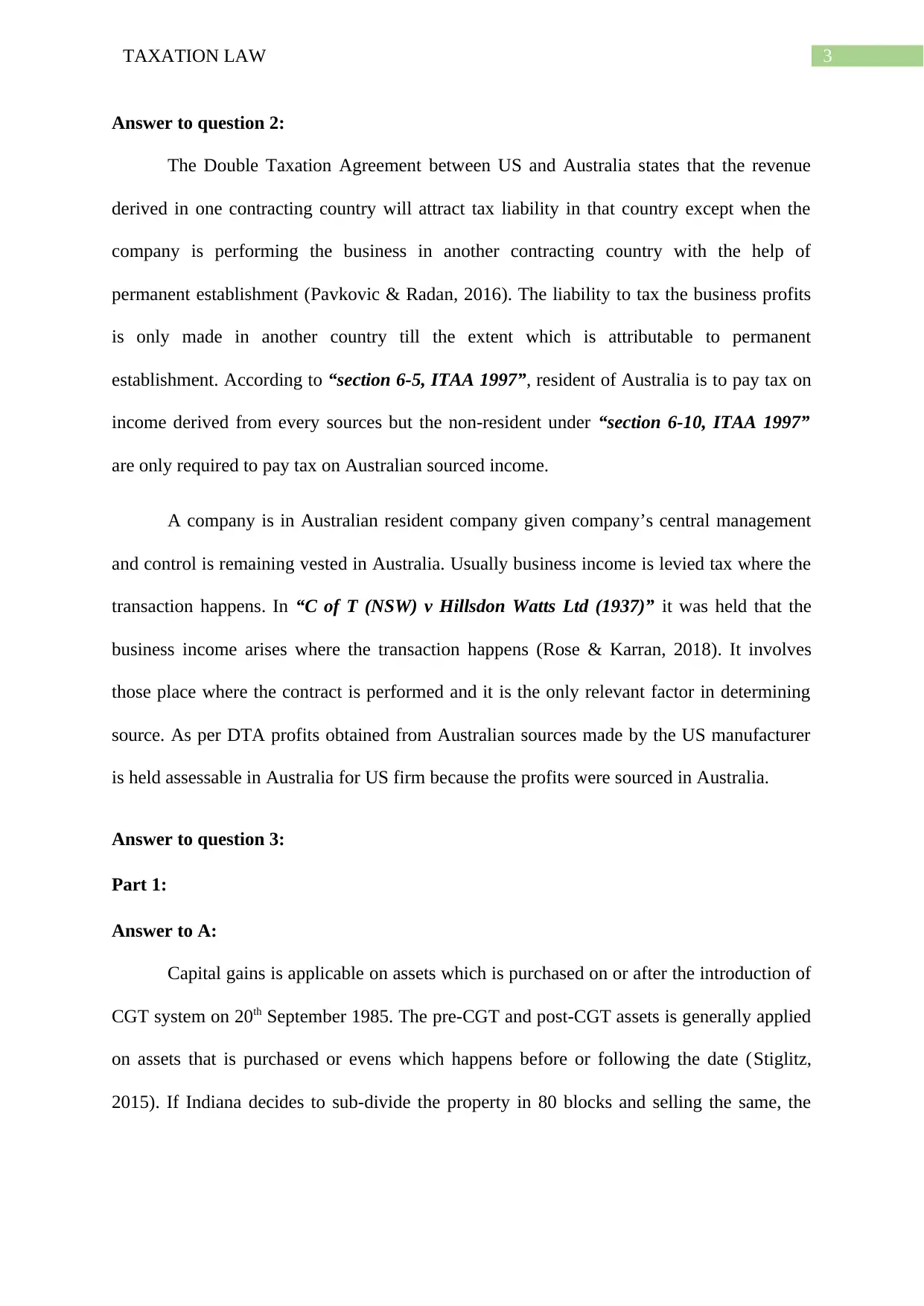
3TAXATION LAW
Answer to question 2:
The Double Taxation Agreement between US and Australia states that the revenue
derived in one contracting country will attract tax liability in that country except when the
company is performing the business in another contracting country with the help of
permanent establishment (Pavkovic & Radan, 2016). The liability to tax the business profits
is only made in another country till the extent which is attributable to permanent
establishment. According to “section 6-5, ITAA 1997”, resident of Australia is to pay tax on
income derived from every sources but the non-resident under “section 6-10, ITAA 1997”
are only required to pay tax on Australian sourced income.
A company is in Australian resident company given company’s central management
and control is remaining vested in Australia. Usually business income is levied tax where the
transaction happens. In “C of T (NSW) v Hillsdon Watts Ltd (1937)” it was held that the
business income arises where the transaction happens (Rose & Karran, 2018). It involves
those place where the contract is performed and it is the only relevant factor in determining
source. As per DTA profits obtained from Australian sources made by the US manufacturer
is held assessable in Australia for US firm because the profits were sourced in Australia.
Answer to question 3:
Part 1:
Answer to A:
Capital gains is applicable on assets which is purchased on or after the introduction of
CGT system on 20th September 1985. The pre-CGT and post-CGT assets is generally applied
on assets that is purchased or evens which happens before or following the date (Stiglitz,
2015). If Indiana decides to sub-divide the property in 80 blocks and selling the same, the
Answer to question 2:
The Double Taxation Agreement between US and Australia states that the revenue
derived in one contracting country will attract tax liability in that country except when the
company is performing the business in another contracting country with the help of
permanent establishment (Pavkovic & Radan, 2016). The liability to tax the business profits
is only made in another country till the extent which is attributable to permanent
establishment. According to “section 6-5, ITAA 1997”, resident of Australia is to pay tax on
income derived from every sources but the non-resident under “section 6-10, ITAA 1997”
are only required to pay tax on Australian sourced income.
A company is in Australian resident company given company’s central management
and control is remaining vested in Australia. Usually business income is levied tax where the
transaction happens. In “C of T (NSW) v Hillsdon Watts Ltd (1937)” it was held that the
business income arises where the transaction happens (Rose & Karran, 2018). It involves
those place where the contract is performed and it is the only relevant factor in determining
source. As per DTA profits obtained from Australian sources made by the US manufacturer
is held assessable in Australia for US firm because the profits were sourced in Australia.
Answer to question 3:
Part 1:
Answer to A:
Capital gains is applicable on assets which is purchased on or after the introduction of
CGT system on 20th September 1985. The pre-CGT and post-CGT assets is generally applied
on assets that is purchased or evens which happens before or following the date (Stiglitz,
2015). If Indiana decides to sub-divide the property in 80 blocks and selling the same, the
Paraphrase This Document
Need a fresh take? Get an instant paraphrase of this document with our AI Paraphraser
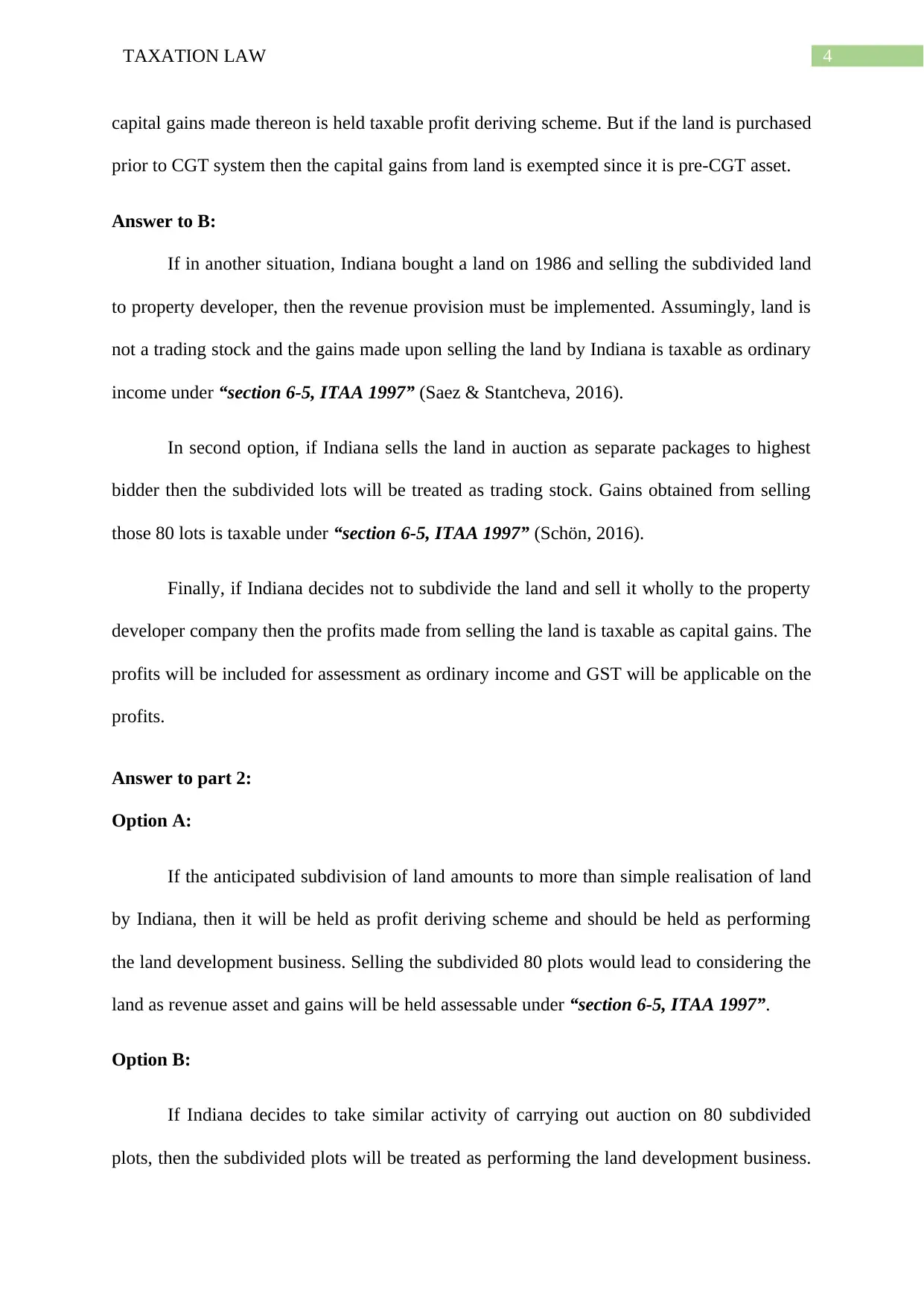
4TAXATION LAW
capital gains made thereon is held taxable profit deriving scheme. But if the land is purchased
prior to CGT system then the capital gains from land is exempted since it is pre-CGT asset.
Answer to B:
If in another situation, Indiana bought a land on 1986 and selling the subdivided land
to property developer, then the revenue provision must be implemented. Assumingly, land is
not a trading stock and the gains made upon selling the land by Indiana is taxable as ordinary
income under “section 6-5, ITAA 1997” (Saez & Stantcheva, 2016).
In second option, if Indiana sells the land in auction as separate packages to highest
bidder then the subdivided lots will be treated as trading stock. Gains obtained from selling
those 80 lots is taxable under “section 6-5, ITAA 1997” (Schön, 2016).
Finally, if Indiana decides not to subdivide the land and sell it wholly to the property
developer company then the profits made from selling the land is taxable as capital gains. The
profits will be included for assessment as ordinary income and GST will be applicable on the
profits.
Answer to part 2:
Option A:
If the anticipated subdivision of land amounts to more than simple realisation of land
by Indiana, then it will be held as profit deriving scheme and should be held as performing
the land development business. Selling the subdivided 80 plots would lead to considering the
land as revenue asset and gains will be held assessable under “section 6-5, ITAA 1997”.
Option B:
If Indiana decides to take similar activity of carrying out auction on 80 subdivided
plots, then the subdivided plots will be treated as performing the land development business.
capital gains made thereon is held taxable profit deriving scheme. But if the land is purchased
prior to CGT system then the capital gains from land is exempted since it is pre-CGT asset.
Answer to B:
If in another situation, Indiana bought a land on 1986 and selling the subdivided land
to property developer, then the revenue provision must be implemented. Assumingly, land is
not a trading stock and the gains made upon selling the land by Indiana is taxable as ordinary
income under “section 6-5, ITAA 1997” (Saez & Stantcheva, 2016).
In second option, if Indiana sells the land in auction as separate packages to highest
bidder then the subdivided lots will be treated as trading stock. Gains obtained from selling
those 80 lots is taxable under “section 6-5, ITAA 1997” (Schön, 2016).
Finally, if Indiana decides not to subdivide the land and sell it wholly to the property
developer company then the profits made from selling the land is taxable as capital gains. The
profits will be included for assessment as ordinary income and GST will be applicable on the
profits.
Answer to part 2:
Option A:
If the anticipated subdivision of land amounts to more than simple realisation of land
by Indiana, then it will be held as profit deriving scheme and should be held as performing
the land development business. Selling the subdivided 80 plots would lead to considering the
land as revenue asset and gains will be held assessable under “section 6-5, ITAA 1997”.
Option B:
If Indiana decides to take similar activity of carrying out auction on 80 subdivided
plots, then the subdivided plots will be treated as performing the land development business.
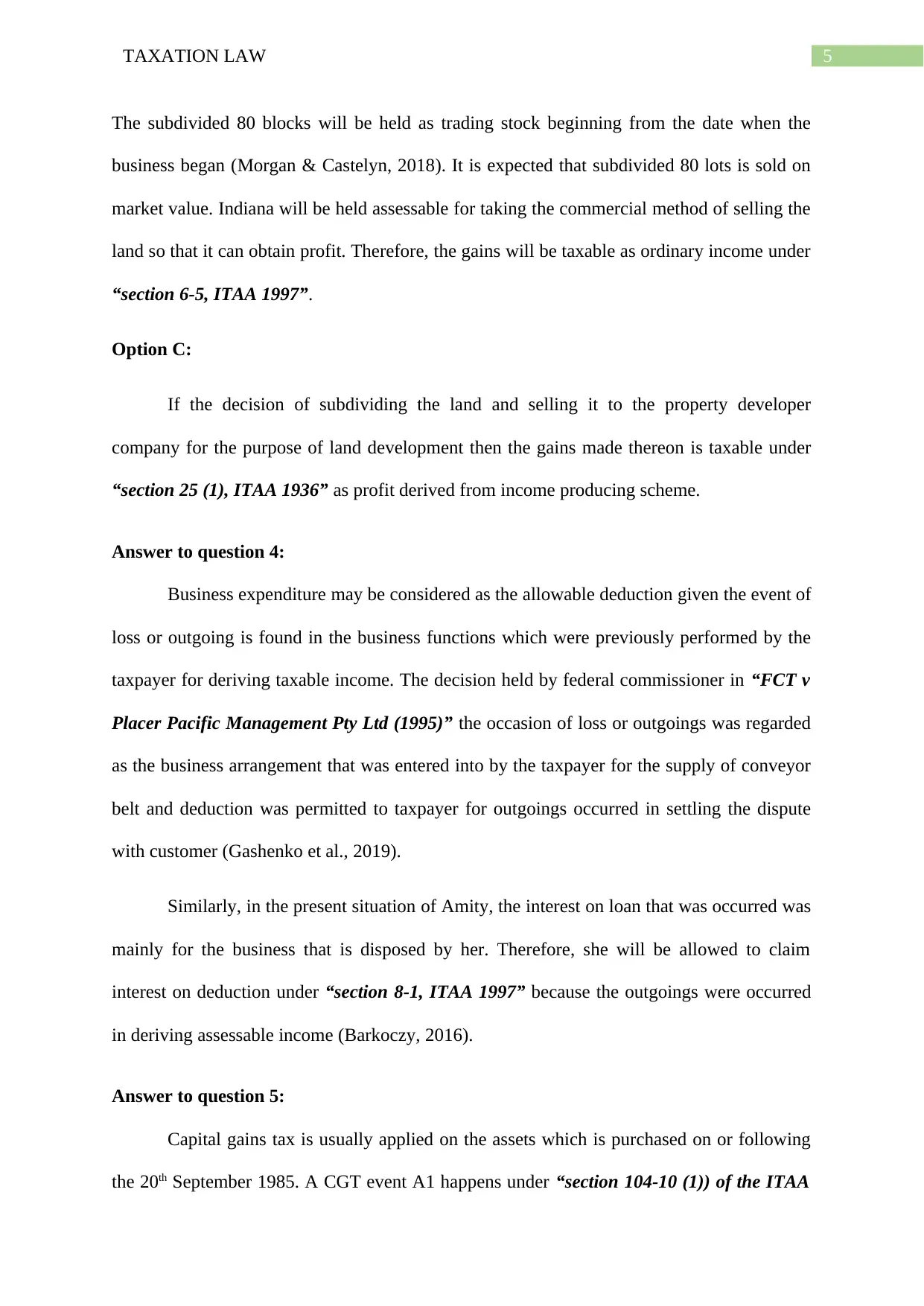
5TAXATION LAW
The subdivided 80 blocks will be held as trading stock beginning from the date when the
business began (Morgan & Castelyn, 2018). It is expected that subdivided 80 lots is sold on
market value. Indiana will be held assessable for taking the commercial method of selling the
land so that it can obtain profit. Therefore, the gains will be taxable as ordinary income under
“section 6-5, ITAA 1997”.
Option C:
If the decision of subdividing the land and selling it to the property developer
company for the purpose of land development then the gains made thereon is taxable under
“section 25 (1), ITAA 1936” as profit derived from income producing scheme.
Answer to question 4:
Business expenditure may be considered as the allowable deduction given the event of
loss or outgoing is found in the business functions which were previously performed by the
taxpayer for deriving taxable income. The decision held by federal commissioner in “FCT v
Placer Pacific Management Pty Ltd (1995)” the occasion of loss or outgoings was regarded
as the business arrangement that was entered into by the taxpayer for the supply of conveyor
belt and deduction was permitted to taxpayer for outgoings occurred in settling the dispute
with customer (Gashenko et al., 2019).
Similarly, in the present situation of Amity, the interest on loan that was occurred was
mainly for the business that is disposed by her. Therefore, she will be allowed to claim
interest on deduction under “section 8-1, ITAA 1997” because the outgoings were occurred
in deriving assessable income (Barkoczy, 2016).
Answer to question 5:
Capital gains tax is usually applied on the assets which is purchased on or following
the 20th September 1985. A CGT event A1 happens under “section 104-10 (1)) of the ITAA
The subdivided 80 blocks will be held as trading stock beginning from the date when the
business began (Morgan & Castelyn, 2018). It is expected that subdivided 80 lots is sold on
market value. Indiana will be held assessable for taking the commercial method of selling the
land so that it can obtain profit. Therefore, the gains will be taxable as ordinary income under
“section 6-5, ITAA 1997”.
Option C:
If the decision of subdividing the land and selling it to the property developer
company for the purpose of land development then the gains made thereon is taxable under
“section 25 (1), ITAA 1936” as profit derived from income producing scheme.
Answer to question 4:
Business expenditure may be considered as the allowable deduction given the event of
loss or outgoing is found in the business functions which were previously performed by the
taxpayer for deriving taxable income. The decision held by federal commissioner in “FCT v
Placer Pacific Management Pty Ltd (1995)” the occasion of loss or outgoings was regarded
as the business arrangement that was entered into by the taxpayer for the supply of conveyor
belt and deduction was permitted to taxpayer for outgoings occurred in settling the dispute
with customer (Gashenko et al., 2019).
Similarly, in the present situation of Amity, the interest on loan that was occurred was
mainly for the business that is disposed by her. Therefore, she will be allowed to claim
interest on deduction under “section 8-1, ITAA 1997” because the outgoings were occurred
in deriving assessable income (Barkoczy, 2016).
Answer to question 5:
Capital gains tax is usually applied on the assets which is purchased on or following
the 20th September 1985. A CGT event A1 happens under “section 104-10 (1)) of the ITAA
⊘ This is a preview!⊘
Do you want full access?
Subscribe today to unlock all pages.

Trusted by 1+ million students worldwide
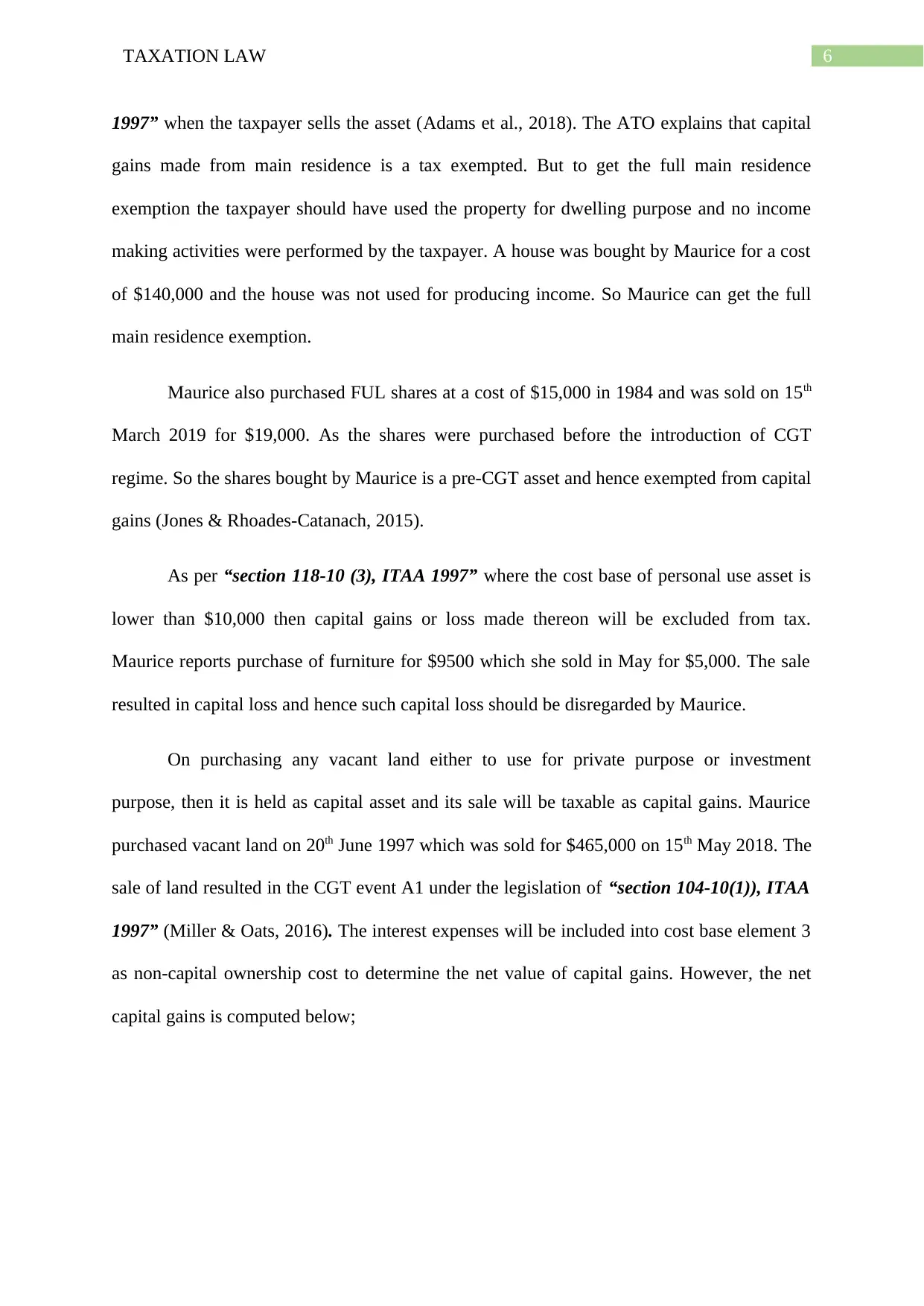
6TAXATION LAW
1997” when the taxpayer sells the asset (Adams et al., 2018). The ATO explains that capital
gains made from main residence is a tax exempted. But to get the full main residence
exemption the taxpayer should have used the property for dwelling purpose and no income
making activities were performed by the taxpayer. A house was bought by Maurice for a cost
of $140,000 and the house was not used for producing income. So Maurice can get the full
main residence exemption.
Maurice also purchased FUL shares at a cost of $15,000 in 1984 and was sold on 15th
March 2019 for $19,000. As the shares were purchased before the introduction of CGT
regime. So the shares bought by Maurice is a pre-CGT asset and hence exempted from capital
gains (Jones & Rhoades-Catanach, 2015).
As per “section 118-10 (3), ITAA 1997” where the cost base of personal use asset is
lower than $10,000 then capital gains or loss made thereon will be excluded from tax.
Maurice reports purchase of furniture for $9500 which she sold in May for $5,000. The sale
resulted in capital loss and hence such capital loss should be disregarded by Maurice.
On purchasing any vacant land either to use for private purpose or investment
purpose, then it is held as capital asset and its sale will be taxable as capital gains. Maurice
purchased vacant land on 20th June 1997 which was sold for $465,000 on 15th May 2018. The
sale of land resulted in the CGT event A1 under the legislation of “section 104-10(1)), ITAA
1997” (Miller & Oats, 2016). The interest expenses will be included into cost base element 3
as non-capital ownership cost to determine the net value of capital gains. However, the net
capital gains is computed below;
1997” when the taxpayer sells the asset (Adams et al., 2018). The ATO explains that capital
gains made from main residence is a tax exempted. But to get the full main residence
exemption the taxpayer should have used the property for dwelling purpose and no income
making activities were performed by the taxpayer. A house was bought by Maurice for a cost
of $140,000 and the house was not used for producing income. So Maurice can get the full
main residence exemption.
Maurice also purchased FUL shares at a cost of $15,000 in 1984 and was sold on 15th
March 2019 for $19,000. As the shares were purchased before the introduction of CGT
regime. So the shares bought by Maurice is a pre-CGT asset and hence exempted from capital
gains (Jones & Rhoades-Catanach, 2015).
As per “section 118-10 (3), ITAA 1997” where the cost base of personal use asset is
lower than $10,000 then capital gains or loss made thereon will be excluded from tax.
Maurice reports purchase of furniture for $9500 which she sold in May for $5,000. The sale
resulted in capital loss and hence such capital loss should be disregarded by Maurice.
On purchasing any vacant land either to use for private purpose or investment
purpose, then it is held as capital asset and its sale will be taxable as capital gains. Maurice
purchased vacant land on 20th June 1997 which was sold for $465,000 on 15th May 2018. The
sale of land resulted in the CGT event A1 under the legislation of “section 104-10(1)), ITAA
1997” (Miller & Oats, 2016). The interest expenses will be included into cost base element 3
as non-capital ownership cost to determine the net value of capital gains. However, the net
capital gains is computed below;
Paraphrase This Document
Need a fresh take? Get an instant paraphrase of this document with our AI Paraphraser
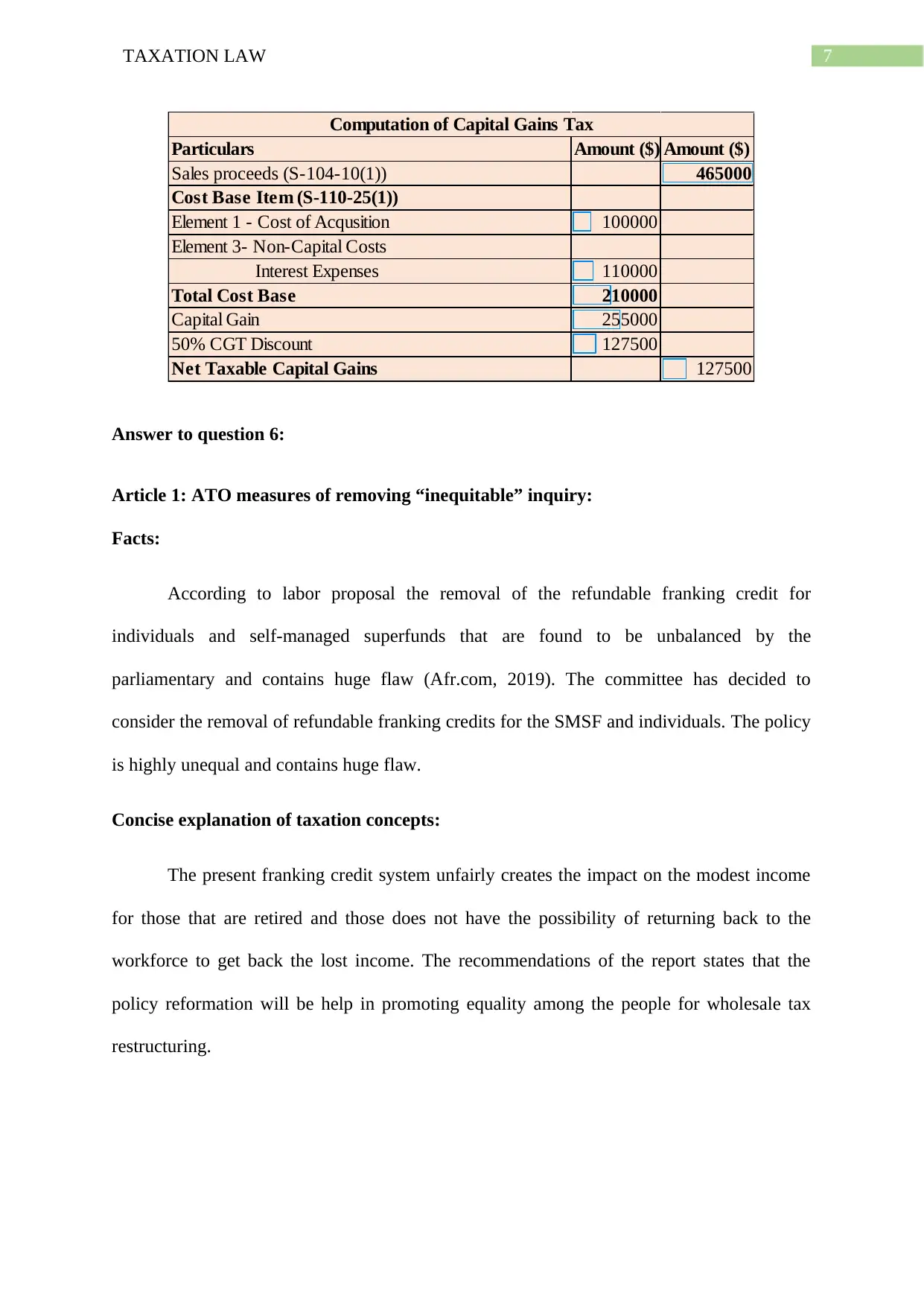
7TAXATION LAW
Particulars Amount ($) Amount ($)
Sales proceeds (S-104-10(1)) 465000
Cost Base Item (S-110-25(1))
Element 1 - Cost of Acqusition 100000
Element 3- Non-Capital Costs
Interest Expenses 110000
Total Cost Base 210000
Capital Gain 255000
50% CGT Discount 127500
Net Taxable Capital Gains 127500
Computation of Capital Gains Tax
Answer to question 6:
Article 1: ATO measures of removing “inequitable” inquiry:
Facts:
According to labor proposal the removal of the refundable franking credit for
individuals and self-managed superfunds that are found to be unbalanced by the
parliamentary and contains huge flaw (Afr.com, 2019). The committee has decided to
consider the removal of refundable franking credits for the SMSF and individuals. The policy
is highly unequal and contains huge flaw.
Concise explanation of taxation concepts:
The present franking credit system unfairly creates the impact on the modest income
for those that are retired and those does not have the possibility of returning back to the
workforce to get back the lost income. The recommendations of the report states that the
policy reformation will be help in promoting equality among the people for wholesale tax
restructuring.
Particulars Amount ($) Amount ($)
Sales proceeds (S-104-10(1)) 465000
Cost Base Item (S-110-25(1))
Element 1 - Cost of Acqusition 100000
Element 3- Non-Capital Costs
Interest Expenses 110000
Total Cost Base 210000
Capital Gain 255000
50% CGT Discount 127500
Net Taxable Capital Gains 127500
Computation of Capital Gains Tax
Answer to question 6:
Article 1: ATO measures of removing “inequitable” inquiry:
Facts:
According to labor proposal the removal of the refundable franking credit for
individuals and self-managed superfunds that are found to be unbalanced by the
parliamentary and contains huge flaw (Afr.com, 2019). The committee has decided to
consider the removal of refundable franking credits for the SMSF and individuals. The policy
is highly unequal and contains huge flaw.
Concise explanation of taxation concepts:
The present franking credit system unfairly creates the impact on the modest income
for those that are retired and those does not have the possibility of returning back to the
workforce to get back the lost income. The recommendations of the report states that the
policy reformation will be help in promoting equality among the people for wholesale tax
restructuring.
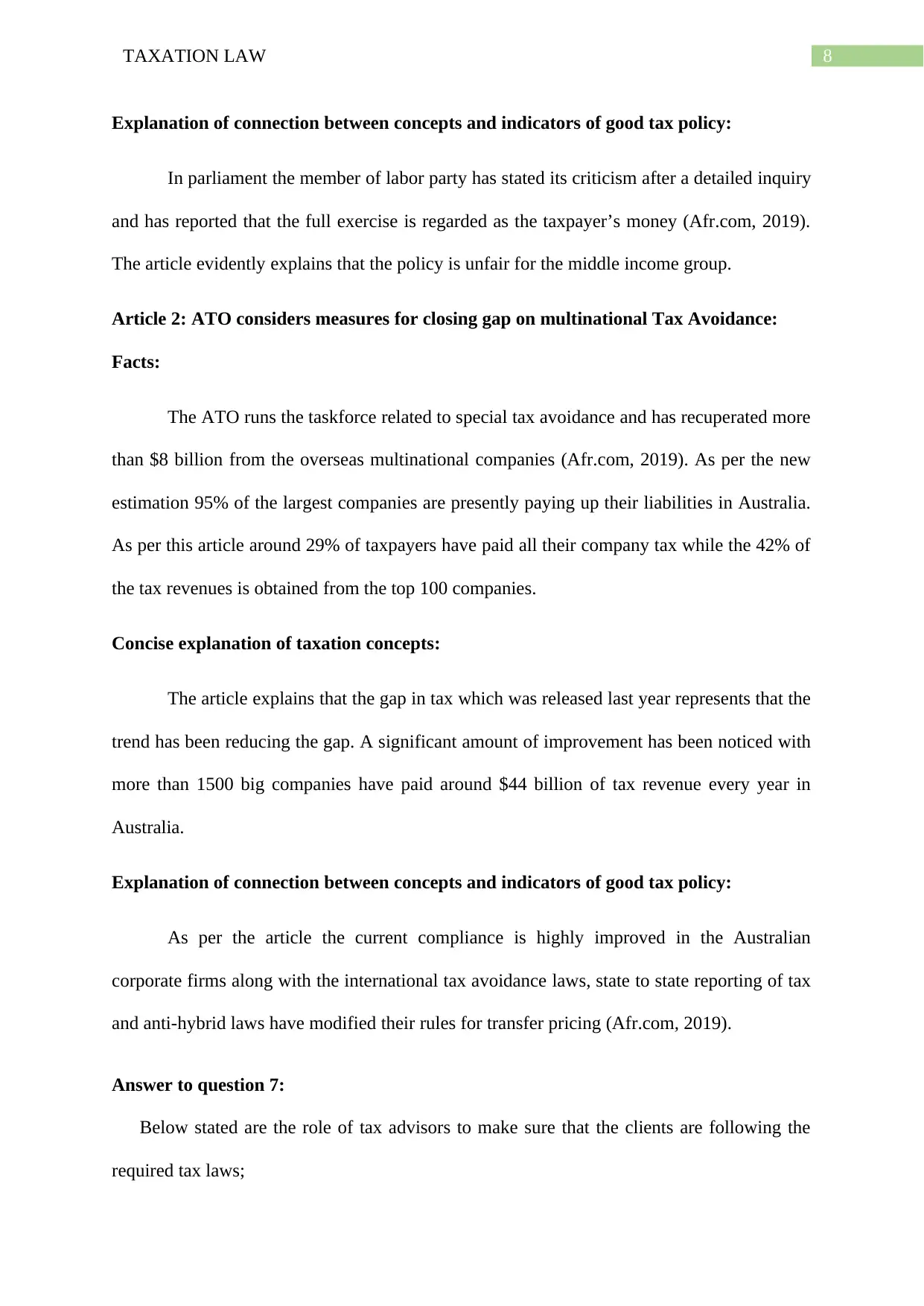
8TAXATION LAW
Explanation of connection between concepts and indicators of good tax policy:
In parliament the member of labor party has stated its criticism after a detailed inquiry
and has reported that the full exercise is regarded as the taxpayer’s money (Afr.com, 2019).
The article evidently explains that the policy is unfair for the middle income group.
Article 2: ATO considers measures for closing gap on multinational Tax Avoidance:
Facts:
The ATO runs the taskforce related to special tax avoidance and has recuperated more
than $8 billion from the overseas multinational companies (Afr.com, 2019). As per the new
estimation 95% of the largest companies are presently paying up their liabilities in Australia.
As per this article around 29% of taxpayers have paid all their company tax while the 42% of
the tax revenues is obtained from the top 100 companies.
Concise explanation of taxation concepts:
The article explains that the gap in tax which was released last year represents that the
trend has been reducing the gap. A significant amount of improvement has been noticed with
more than 1500 big companies have paid around $44 billion of tax revenue every year in
Australia.
Explanation of connection between concepts and indicators of good tax policy:
As per the article the current compliance is highly improved in the Australian
corporate firms along with the international tax avoidance laws, state to state reporting of tax
and anti-hybrid laws have modified their rules for transfer pricing (Afr.com, 2019).
Answer to question 7:
Below stated are the role of tax advisors to make sure that the clients are following the
required tax laws;
Explanation of connection between concepts and indicators of good tax policy:
In parliament the member of labor party has stated its criticism after a detailed inquiry
and has reported that the full exercise is regarded as the taxpayer’s money (Afr.com, 2019).
The article evidently explains that the policy is unfair for the middle income group.
Article 2: ATO considers measures for closing gap on multinational Tax Avoidance:
Facts:
The ATO runs the taskforce related to special tax avoidance and has recuperated more
than $8 billion from the overseas multinational companies (Afr.com, 2019). As per the new
estimation 95% of the largest companies are presently paying up their liabilities in Australia.
As per this article around 29% of taxpayers have paid all their company tax while the 42% of
the tax revenues is obtained from the top 100 companies.
Concise explanation of taxation concepts:
The article explains that the gap in tax which was released last year represents that the
trend has been reducing the gap. A significant amount of improvement has been noticed with
more than 1500 big companies have paid around $44 billion of tax revenue every year in
Australia.
Explanation of connection between concepts and indicators of good tax policy:
As per the article the current compliance is highly improved in the Australian
corporate firms along with the international tax avoidance laws, state to state reporting of tax
and anti-hybrid laws have modified their rules for transfer pricing (Afr.com, 2019).
Answer to question 7:
Below stated are the role of tax advisors to make sure that the clients are following the
required tax laws;
⊘ This is a preview!⊘
Do you want full access?
Subscribe today to unlock all pages.

Trusted by 1+ million students worldwide
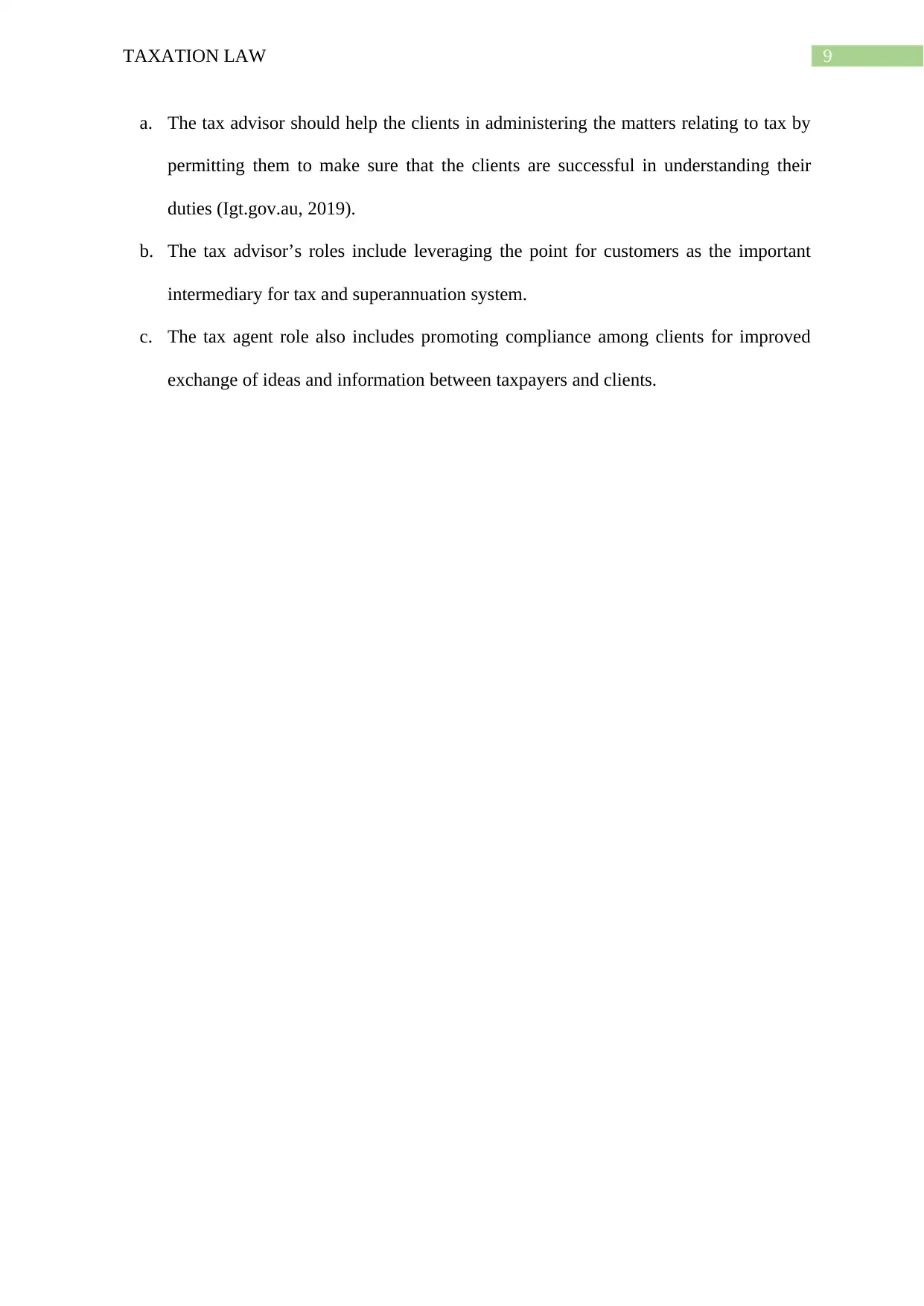
9TAXATION LAW
a. The tax advisor should help the clients in administering the matters relating to tax by
permitting them to make sure that the clients are successful in understanding their
duties (Igt.gov.au, 2019).
b. The tax advisor’s roles include leveraging the point for customers as the important
intermediary for tax and superannuation system.
c. The tax agent role also includes promoting compliance among clients for improved
exchange of ideas and information between taxpayers and clients.
a. The tax advisor should help the clients in administering the matters relating to tax by
permitting them to make sure that the clients are successful in understanding their
duties (Igt.gov.au, 2019).
b. The tax advisor’s roles include leveraging the point for customers as the important
intermediary for tax and superannuation system.
c. The tax agent role also includes promoting compliance among clients for improved
exchange of ideas and information between taxpayers and clients.
Paraphrase This Document
Need a fresh take? Get an instant paraphrase of this document with our AI Paraphraser
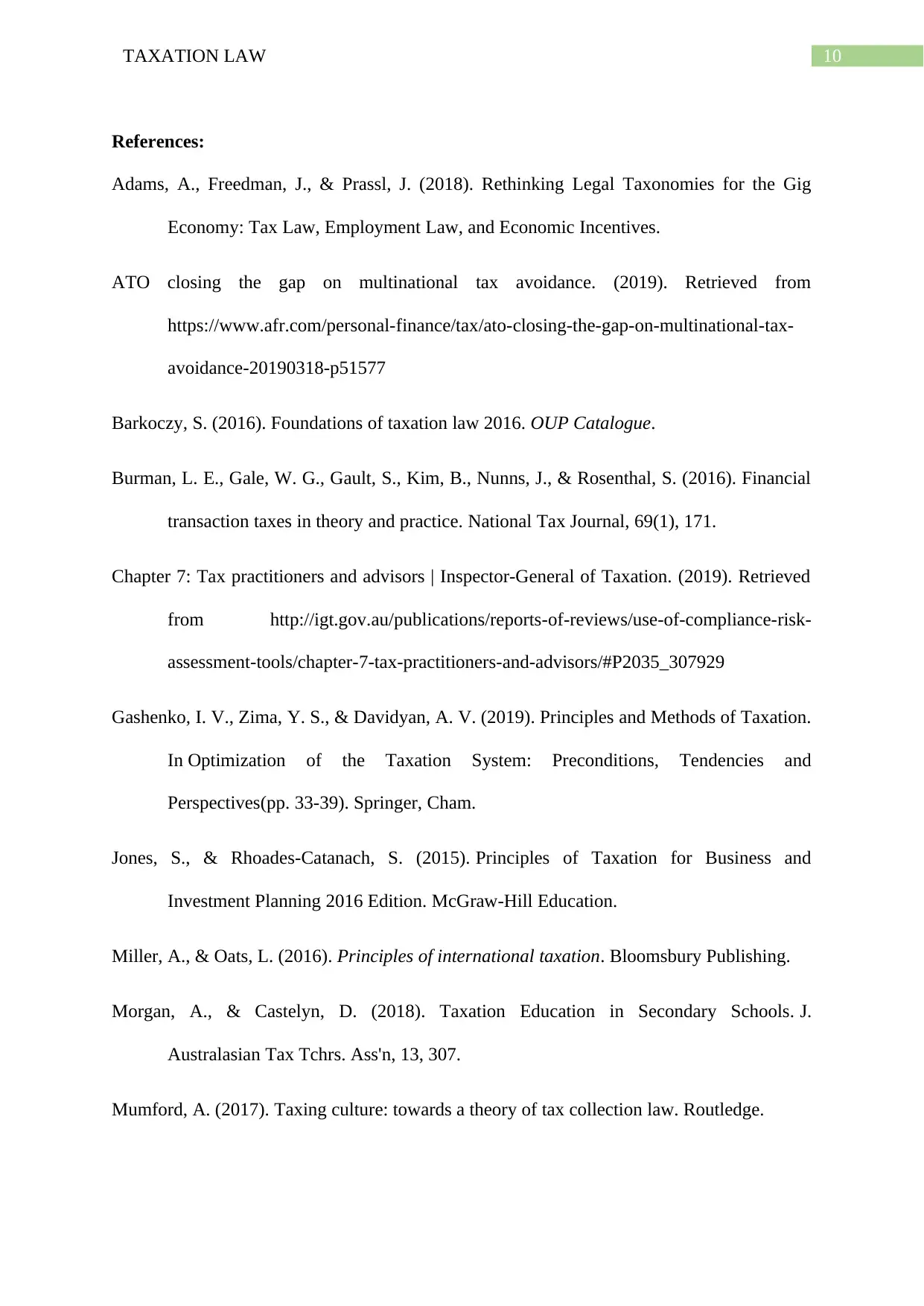
10TAXATION LAW
References:
Adams, A., Freedman, J., & Prassl, J. (2018). Rethinking Legal Taxonomies for the Gig
Economy: Tax Law, Employment Law, and Economic Incentives.
ATO closing the gap on multinational tax avoidance. (2019). Retrieved from
https://www.afr.com/personal-finance/tax/ato-closing-the-gap-on-multinational-tax-
avoidance-20190318-p51577
Barkoczy, S. (2016). Foundations of taxation law 2016. OUP Catalogue.
Burman, L. E., Gale, W. G., Gault, S., Kim, B., Nunns, J., & Rosenthal, S. (2016). Financial
transaction taxes in theory and practice. National Tax Journal, 69(1), 171.
Chapter 7: Tax practitioners and advisors | Inspector-General of Taxation. (2019). Retrieved
from http://igt.gov.au/publications/reports-of-reviews/use-of-compliance-risk-
assessment-tools/chapter-7-tax-practitioners-and-advisors/#P2035_307929
Gashenko, I. V., Zima, Y. S., & Davidyan, A. V. (2019). Principles and Methods of Taxation.
In Optimization of the Taxation System: Preconditions, Tendencies and
Perspectives(pp. 33-39). Springer, Cham.
Jones, S., & Rhoades-Catanach, S. (2015). Principles of Taxation for Business and
Investment Planning 2016 Edition. McGraw-Hill Education.
Miller, A., & Oats, L. (2016). Principles of international taxation. Bloomsbury Publishing.
Morgan, A., & Castelyn, D. (2018). Taxation Education in Secondary Schools. J.
Australasian Tax Tchrs. Ass'n, 13, 307.
Mumford, A. (2017). Taxing culture: towards a theory of tax collection law. Routledge.
References:
Adams, A., Freedman, J., & Prassl, J. (2018). Rethinking Legal Taxonomies for the Gig
Economy: Tax Law, Employment Law, and Economic Incentives.
ATO closing the gap on multinational tax avoidance. (2019). Retrieved from
https://www.afr.com/personal-finance/tax/ato-closing-the-gap-on-multinational-tax-
avoidance-20190318-p51577
Barkoczy, S. (2016). Foundations of taxation law 2016. OUP Catalogue.
Burman, L. E., Gale, W. G., Gault, S., Kim, B., Nunns, J., & Rosenthal, S. (2016). Financial
transaction taxes in theory and practice. National Tax Journal, 69(1), 171.
Chapter 7: Tax practitioners and advisors | Inspector-General of Taxation. (2019). Retrieved
from http://igt.gov.au/publications/reports-of-reviews/use-of-compliance-risk-
assessment-tools/chapter-7-tax-practitioners-and-advisors/#P2035_307929
Gashenko, I. V., Zima, Y. S., & Davidyan, A. V. (2019). Principles and Methods of Taxation.
In Optimization of the Taxation System: Preconditions, Tendencies and
Perspectives(pp. 33-39). Springer, Cham.
Jones, S., & Rhoades-Catanach, S. (2015). Principles of Taxation for Business and
Investment Planning 2016 Edition. McGraw-Hill Education.
Miller, A., & Oats, L. (2016). Principles of international taxation. Bloomsbury Publishing.
Morgan, A., & Castelyn, D. (2018). Taxation Education in Secondary Schools. J.
Australasian Tax Tchrs. Ass'n, 13, 307.
Mumford, A. (2017). Taxing culture: towards a theory of tax collection law. Routledge.
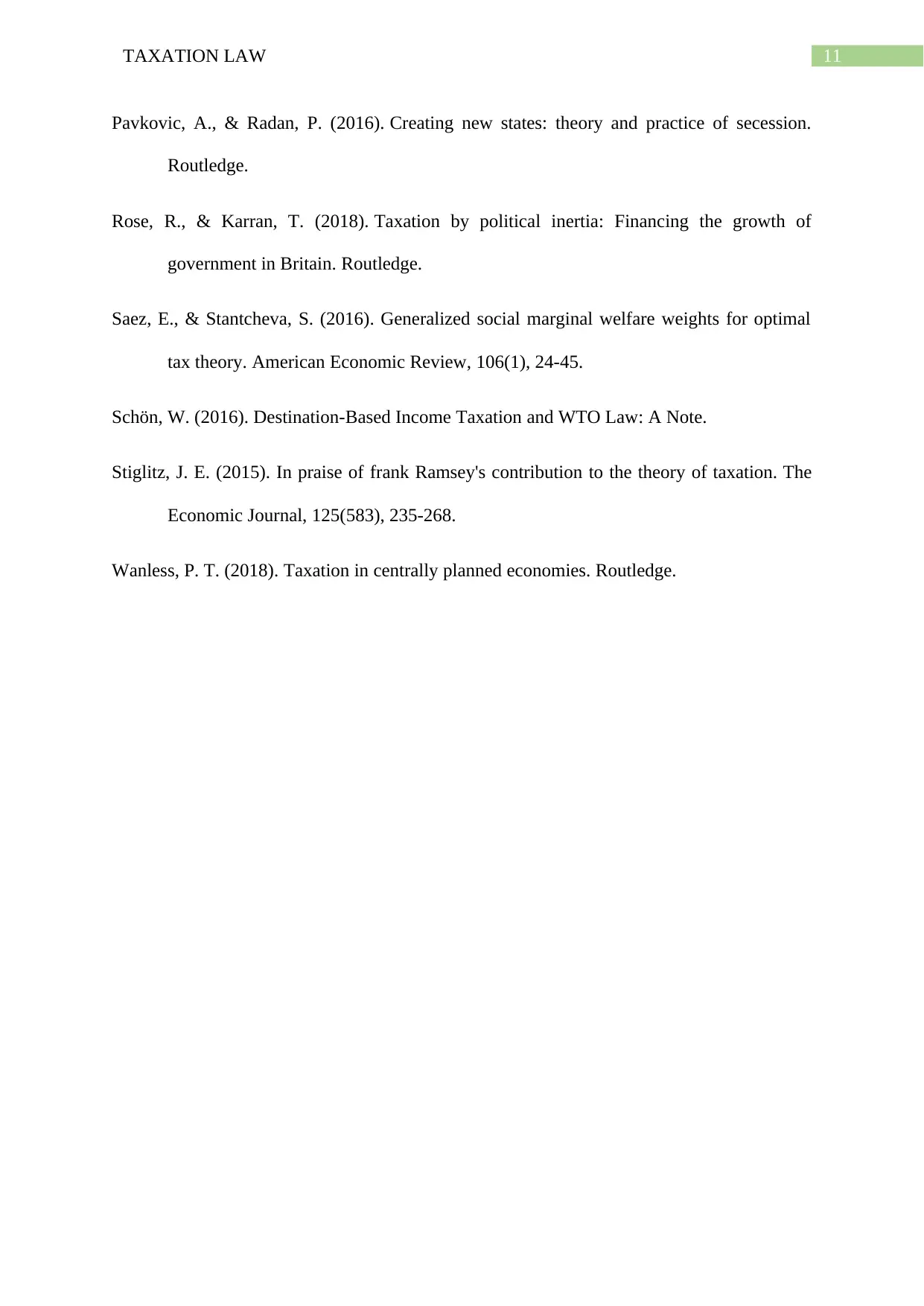
11TAXATION LAW
Pavkovic, A., & Radan, P. (2016). Creating new states: theory and practice of secession.
Routledge.
Rose, R., & Karran, T. (2018). Taxation by political inertia: Financing the growth of
government in Britain. Routledge.
Saez, E., & Stantcheva, S. (2016). Generalized social marginal welfare weights for optimal
tax theory. American Economic Review, 106(1), 24-45.
Schön, W. (2016). Destination-Based Income Taxation and WTO Law: A Note.
Stiglitz, J. E. (2015). In praise of frank Ramsey's contribution to the theory of taxation. The
Economic Journal, 125(583), 235-268.
Wanless, P. T. (2018). Taxation in centrally planned economies. Routledge.
Pavkovic, A., & Radan, P. (2016). Creating new states: theory and practice of secession.
Routledge.
Rose, R., & Karran, T. (2018). Taxation by political inertia: Financing the growth of
government in Britain. Routledge.
Saez, E., & Stantcheva, S. (2016). Generalized social marginal welfare weights for optimal
tax theory. American Economic Review, 106(1), 24-45.
Schön, W. (2016). Destination-Based Income Taxation and WTO Law: A Note.
Stiglitz, J. E. (2015). In praise of frank Ramsey's contribution to the theory of taxation. The
Economic Journal, 125(583), 235-268.
Wanless, P. T. (2018). Taxation in centrally planned economies. Routledge.
⊘ This is a preview!⊘
Do you want full access?
Subscribe today to unlock all pages.

Trusted by 1+ million students worldwide
1 out of 12
Related Documents
Your All-in-One AI-Powered Toolkit for Academic Success.
+13062052269
info@desklib.com
Available 24*7 on WhatsApp / Email
![[object Object]](/_next/static/media/star-bottom.7253800d.svg)
Unlock your academic potential
Copyright © 2020–2025 A2Z Services. All Rights Reserved. Developed and managed by ZUCOL.





